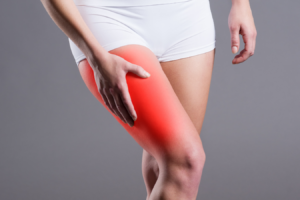 Do you ever experience hip pain flowing from the outside of your hip down the outer edge of your thigh? If so, you may have trochanteric bursitis, a common source of hip pain. This condition may cause dull and/or constant pain that typically worsens with activities like running, walking upstairs, standing up out of a chair, or getting out of your car. Additionally, pain may increase at night while you are sleeping on one side or the other. Read on to learn more about this common hip condition.
Do you ever experience hip pain flowing from the outside of your hip down the outer edge of your thigh? If so, you may have trochanteric bursitis, a common source of hip pain. This condition may cause dull and/or constant pain that typically worsens with activities like running, walking upstairs, standing up out of a chair, or getting out of your car. Additionally, pain may increase at night while you are sleeping on one side or the other. Read on to learn more about this common hip condition.
What is Trochanteric Bursitis?
Basically, the hip contains multiple fluid-filled sacs, called bursae, which are meant to reduce friction when the hip is used. When too much stress or repetitive trauma is placed on the bursa, it becomes inflamed and irritated. Essentially, bursitis is the inflammation and irritation of a bursa sac. With trochanteric bursitis, the particular bursa sac affected is the greater trochanter located on the outside tip of the hip joint.
How is Trochanteric Bursitis treated?
 Treatment for Mild Trochanteric Bursitis
Treatment for Mild Trochanteric Bursitis
For mild cases, most physicians will recommend a physical therapy (PT) program and regular icing of the affected area. Remember when icing to keep a towel between the skin and the ice so you don’t burn yourself. During PT, the goal of stretches and exercises for trochanteric bursitis is to stretch the IT band, which is a muscle that runs from the outside of the hip down the outside of the thigh to the knee.
Often, when the IT band is too tight, it rubs and aggravates the greater trochanter resulting in bursitis. So, stretching out the IT band will help alleviate pain by reducing stress on the trochanteric bursa sac. However, be aware the pain often returns when patients stop their regular stretching and exercises. So before completing your PT program, ask your therapist for an at-home exercise plan to stay proactive. Additionally, losing weight often helps to relieve bursitis due to less pressure on the hip.
Treatment for Severe Trochanteric Bursitis
For more severe cases of trochanteric bursitis, your physician may suggest a cortisone injection. The goal of this steroid injection is to reduce inflammation of the bursa sac. Often, the injection will also contain lidocaine, a mild anesthetic, that should provide some immediate pain relief. Following the injection, patients typically experience progressive pain relief over a number of days or weeks.
What if Conservative Treatments Don’t Work?
Although it is rare, PT and icing the hip may not help. In that case, a physician may consider surgery as an option if the patient is eligible. During trochanteric bursitis surgery, a surgeon splits the tissue and tendon outside of the greater trochanter (or outside edge of the hip) and bursa sac so the trochanteric bursa sac is exposed. Then, they remove the bursa and will often loosely sew the tissue and tendon back together. However, they may not sew them back together at all. The surgeon does this so there’s less pressure on the greater trochanter and the tendons can heal more loosely than if they were securely sewn against the hip bone. Essentially, this technique relieves friction from the area and should also help relieve the patient’s pain. Luckily, this is a simple outpatient procedure. In fact, patients should be able to get up and walk around for short periods of time as soon as the very next day.
When should I talk to a doctor?
As always, if you have any form of undiagnosed chronic pain it is important to see an expert ASAP to determine the root cause of the pain. For example, inflammation of the muscles around the hip and pelvis could hip could instead be the cause of your hip and/or outer leg pain – not bursitis. So, consult an expert to rule out that and any other condition and ensure you receive a proper diagnosis and treatment plan.
Advanced Ortho and Spine Can Help.
At Advanced Ortho and Spine (AOS), we’ve cared for numerous patients with trochanteric bursitis. Most are able to get back to living their best lives with only conservative treatment. Dr. Christopher Cook and Dr. Lee Swiderek at AOS specialize in treating various orthopaedic conditions, including trochanteric bursitis. Please request an appointment online or call us at 615.885.0200 to schedule yours today.
 Dr. Christopher Cook is a Board-Certified Orthopaedic Surgeon and Sports Medicine & Joint Replacement Specialist at Advanced Ortho and Spine. He provides a full spectrum of Joint Replacement, Sports Medicine, and Shoulder & Upper Extremity services. Contact us today for more information or to request an appointment. Contact us today for more information or to request an appointment.
Dr. Christopher Cook is a Board-Certified Orthopaedic Surgeon and Sports Medicine & Joint Replacement Specialist at Advanced Ortho and Spine. He provides a full spectrum of Joint Replacement, Sports Medicine, and Shoulder & Upper Extremity services. Contact us today for more information or to request an appointment. Contact us today for more information or to request an appointment.
 Dr. Lee Swiderek is a Fellowship-Trained Orthopedic Surgeon & Joint Replacement Specialist at Advanced Ortho and Spine. He provides a full spectrum of Joint Replacement and Complex Hip and Knee Reconstruction services. Contact us today for more information or to request an appointment.
Dr. Lee Swiderek is a Fellowship-Trained Orthopedic Surgeon & Joint Replacement Specialist at Advanced Ortho and Spine. He provides a full spectrum of Joint Replacement and Complex Hip and Knee Reconstruction services. Contact us today for more information or to request an appointment.

With two locations near Nashville in Mt. Juliet and Hermitage, Advanced Ortho and Spine provides patients with high-quality, personalized care while advancing orthopaedic excellence. Contact us today to learn more or to schedule your appointment.
Disclaimer: This blog provides general information and discussions about health and related subjects. The information and other content provided in this blog, or in any linked materials, are not intended and should not be construed as medical advice, nor is the information a substitute for professional medical expertise or treatment.If you or any other person has a medical concern, you should consult with your healthcare provider or seek other professional medical treatment. Never disregard professional medical advice or delay in seeking it because of something read on this blog or in any linked materials. If you think you may have a medical emergency, call your doctor or emergency services immediately.
The opinions and views expressed on this blog and website have no relation to those of any academic, hospital, health practice, or other institution.

